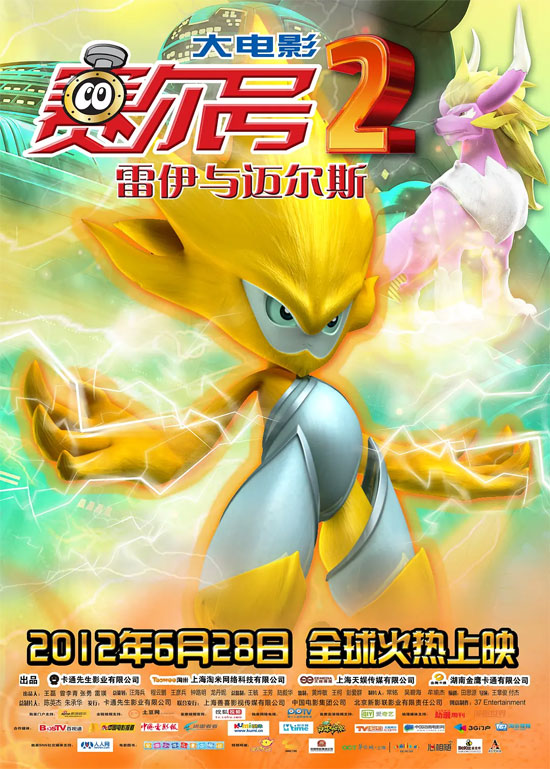Film Name: 赛尔号大电影2之雷伊与迈尔斯 / Seer II

I admit I went into this film with preconceived notions from last year’s “Seer 1.” That was an utterly terrible movie—from production values to plot, there was nothing remotely commendable about it. So much so that when I tried to write a review, I couldn’t bring myself to put pen to paper and ultimately gave up. What infuriates me most is that it actually did quite well at the box office. You know how when a subpar product sells well due to clever marketing, especially when it’s positioned as a long-term brand-building effort, it’s essentially digging its own grave? Not just its own, but the entire industry’s.
Still, this year, driven by a desire to support domestic animation, I steeled myself, lowered my expectations to negative one hundred, and walked into the theater for “Seer II.” During the pre-show ads, a child nearby impatiently asked, “Why isn’t it starting yet?” My heart sank. I feared the film would disappoint them. But I quickly found my overly conscientious attitude rather laughable.
But—but—what I never dared imagine was this: when the film opened with Miles being chased by pirates through a valley, holy crap, is this really a domestic animation? I actually had this bizarre hallucination. Soon, the opening theme began to play. The theme song is a signature feature of the “Seer” series. While the familiar “Seer, Seer” melody faintly stirred up unpleasant memories from last year, it also vaguely stirred up my hopes for this year’s film.
The plot unfolds through a dialogue between Xiao Xi and his friends. What astonished me was the film’s technical quality, which showed a marked improvement over the previous installment. It seems the involvement of the new production company, 37 Entertainment, has indeed injected fresh technical excellence into the film. Throughout the rest of the viewing experience, elements like visuals, action sequences, and pacing—fundamental yet often problematic aspects in Chinese animation—no longer drew my attention. The film’s high-quality technical polish allowed me to transcend superficial concerns, freeing my focus and thought to fully engage with the story and characters.
Sai Xiaoxi’s pet companion initially didn’t catch my attention, as protagonists with pets are common in animated films. It wasn’t until the Seer Spirit Tournament, where contestants produced capsule-like objects from which little spirits emerged, that I realized this did bear some resemblance to “Pokémon.” However, I don’t see anything wrong with ‘Seer’ emulating “Pokémon”‘s pet-raising battle model, as long as it incorporates original elements rather than copying even the storyboards.
A key factor in Pokémon’s success lies in its vast, intricate information system and the sense of accomplishment children feel upon mastering it. Seer effectively captures this essence—from creature names and move titles to elemental types and classifications, everything is complex yet meticulously organized. While playing the game, children acquire vast amounts of information that may seem useless in daily life but holds immense value within the Seer universe. This mastery allows them to escape the constraints of reality, fostering a sense of immersion and accomplishment within the game’s new world. Of course, other social network-based children’s games also perform well in this regard.
The film’s greatest strength lies in its portrayal of Sai Xiaoxi and his father, along with their profound familial bond. The father’s lowly status naturally becomes a reality his son struggles to confront, yet this very conflict adds weight to the emotional arc where Sai Xiaoxi’s perspective shifts, elevating their relationship to new heights. It’s genuinely refreshing that amidst a battle-centric narrative, the film weaves in such a compelling, unforced emotional thread.
One minor misstep lies in Xiao Ke’s line: “My dad is Klo.” Both its phrasing and tone echo the infamous “My dad is Li Gang” scandal that rocked the nation a couple years ago. While the film wholeheartedly celebrates the simple bond between Sai Xiaoxi and his father, it avoids any satire toward Xiao Ke, who leans on his father’s fame. Young viewers might even conclude that having a powerful dad is what truly matters.
Another innovation over its predecessor lies in the portrayal of the Seers’ facial expressions. While the eyes in “Seer 1” were relatively static, in “Seer II” the characters’ eyes are rendered on digital screens. I paid close attention and found the eyes and gazes to be remarkably expressive and dynamic, greatly enhancing the depiction of inner emotions and subtle character nuances.
“Seer II” handles Ray’s screen time far more effectively than “Legend of The Moles 2” did with RK. He appears at pivotal moments without overuse. Miles’ escape from the pirates, though somewhat simplified and not pushed to extremes, remains logically grounded in his son’s call for help. This is the strength of the work—every detail feels plausible. While there’s room for improvement, it avoids major flaws. This sense of coherence hasn’t struck me since watching “Pleasant Goat and Big Big Wolf 3” last year.
That said, I personally felt young Miles could have been portrayed as a bit cuter. His current appearance is somewhat dopey, and the scene where he’s tormented by pirates in front of his brainwashed father felt overly brutal. The crystal stone hanging around his neck getting scraped by a pebble on the ground and falling off without him noticing also feels questionable. Physically simulating that process in my mind, it seems unlikely. Regardless, as a character, Little Miles’ journey—from the grief of losing his father, to the fear of a new environment, to gradually accepting the care of the little Sailors, and finally becoming friends with Sailor Xiao Xi—is fundamentally successful.
“Seer II” not only made me see Sailor Ship in a new light but also gave me renewed confidence in domestic animation. From this perspective, I truly want to say: Seer, thank you!
Please specify:Anime Phone Cases » Seer II 2012 Animation Film Review: I want to say thank you.